Analysis of Selected Water Quality Indicators from Runoff during Potato Cultivation after Natural Precipitation
Abstract
:1. Introduction
2. Materials and Methods
2.1. Study Area
2.2. Methodology and Data
- Base dose 120 kg N ha−1 before planting (variant 1)
- Base dose 120 kg N ha−1 before planting + 1 foliar application of 9% solution of urea, 400 L ha−1—16.5 kg N ha−1 (variant 2)
- Base dose 120 kg N ha−1 before planting + 2 foliar applications of 9% solution of urea, 400 L ha−1—16.5 kg N ha−1 (variant 3)
- Variant 1: 50 kg N ha−1 + 0 kg P2O5 ha−1—application before planting
- Variant 2: 100 kg N ha−1 + 0 kg P2O5 ha−1—application before planting
- Variant 3: 150 kg N ha−1 + 0 kg P2O5 ha−1—application before planting
- Variant 4: 100 kg N ha−1 + 60 kg P2O5 ha−1—application before planting
- Variant 5: 100 kg N ha−1 + 120 kg P2O5 ha−1—application before planting
- Variant 1: application of N 60 kg ha−1 + P2O5 40 kg ha−1 + K2O 40 kg ha−1 before planting + ploughing in 38 t ha−1 of manure in autumn
- Variant 1: application of N 60 kg ha−1 + P2O5 53 kg ha−1 + K2O 122 kg ha−1 before planting + P2O5 53 kg ha−1 in autumn + ploughing in 25 t ha−1 of manure in autumn
3. Results and Discussion
3.1. Runoff
3.2. Phosphorus
3.3. Nitrates
3.4. Pesticides
4. Conclusions
Author Contributions
Funding
Institutional Review Board Statement
Informed Consent Statement
Data Availability Statement
Conflicts of Interest
References
- Ribaudo, M.; Johansson, R. Water quality: Impacts of agriculture. In Water Quality: Physical, Chemical and Biological Characteristics; Ertuð, K., Mirza, I., Eds.; Nova Science Publishers: New York, NY, USA, 2009; ISBN 978-1-60741-633-3. [Google Scholar]
- Heathwaite, A.L.; Quinn, P.F.; Hewett, C.J.M. Modelling and managing critical source areas of diffuse pollution from agricultural land using flow connectivity simulation. J. Hydrol. 2005, 304, 446–461. [Google Scholar] [CrossRef]
- Mu, W.B.; Yu, F.L.; Li, C.Z.; Xie, Y.B.; Tian, J.Y.; Liu, J.; Zhao, N.N. Effects of rainfall intensity and slope gradient on runoff and soil moisture content on different growing stages of spring maize. Water 2015, 7, 2990–3008. [Google Scholar] [CrossRef] [Green Version]
- Ministry of Agriculture of the Czech Republic. Guideline for Protection of Agricultural Land Against Erosion. Available online: http://eagri.cz/public/web/file/293635/MZE_prirucka_ochrany_proti_erozi_zemedelske_pudy_2017.pdf (accessed on 24 March 2020).
- Lefrancq, M.; Jadas-Hécart, A.; La Jeunesse, I.; Landry, D.; Payraudea, S. High frequency monitoring of pesticides in runoff water to improve understanding of their transport and environmental impacts. Sci. Total. Environ. 2017, 587–588, 75–86. [Google Scholar] [CrossRef] [Green Version]
- Martínez Fernández, J.; Fitz, C.; Esteve Selma, M.A.; Guaita, N.; Martínez-López, J. Modelización del efecto de los cambios de uso del suelo sobre los flujos de nutrientes en cuencas agrícolas costeras: El caso del Mar Menor (Sudeste de España). Ecosistemas 2013, 22, 84–94. [Google Scholar] [CrossRef] [Green Version]
- Satchithanantham, S.; English, B.; Wilson, H. Seasonality of phosphorus and nitrate retention in riparian buffers. J. Environ. Qual. 2018, 48, 915–921. [Google Scholar] [CrossRef] [PubMed] [Green Version]
- IPCC Working Group I. IPCC Advances Work on Final Product of Upcoming Assessment Report; IPCC: Geneva, Switzerland. Available online: https://www.ipcc.ch/2021/08/16/pr-syr (accessed on 22 July 2021).
- Balková, M.; Kubalíková, L.; Prokopová, M.; Sedlák, P.; Bajer, A. Ecosystem services of vegetation features as the multifunction anti-erosion measures in the Czech Republic in 2019 and its 30-year prediction. Agriculture 2021, 11, 105. [Google Scholar] [CrossRef]
- Banski, J. Phases to the transformation of agriculture in Central Europe–Selected processes and their results. Agric. Econ. 2018, 64, 546–553. [Google Scholar] [CrossRef]
- Nerušil, P.; Kohoutek, A.; Odstrčilová, V.; Vach, M.; Javůrek, M.; Strašil, Z. The Use of Minimization and Conservation Tillage Technologies in Order to Reduce Water Erosion on Cultivated Lands; Certified methodology for practice; The Crop Research Institute: Prague, Czech Republic, 2015. [Google Scholar]
- Elser, J.J.; Bracken, M.E.; Cleland, E.E.; Gruner, D.S.; Harpole, W.S.; Hillebrand, H.; Ngai, J.T.; Seabloom, E.W.; Shurin, J.B.; Smith, J.E. Global analysis of nitrogen and phosphorus limitation of primary producers in freshwater, marine and terrestrial ecosystems. Ecol. Lett. 2007, 10, 1135–1142. [Google Scholar] [CrossRef] [Green Version]
- Heisler, J.; Glibert, P.M.; Burkholder, J.M.; Anderson, D.M.; Cochlan, W.; Dennison, W.C.; Dortch, Q.; Gobler, C.J.; Heil, C.A.; Humphries, E.; et al. Eutrophication and harmful algal blooms: A scientific consensus. Harmful Algae 2008, 8, 3–13. [Google Scholar] [CrossRef] [Green Version]
- Eugercios Silva, A.R.; Álvarez-Cobelas, M.; Montero González, E. Impactos del nitrógeno agrícola en los ecosistemas acuáticos. Ecosistemas 2017, 26, 37–44. [Google Scholar] [CrossRef] [Green Version]
- Fučík, P.; Kaplická, M.; Zajíček, A. Diffuse sources of phosphorus in agricultural catchment of small water courses. In Proceedings of the Nutrient Pollution of Surface: Causes, Impacts and Options for Solution of (Eu)Trophication, Prague, Czech Republic, 11 June 2009; Czech Association of Scientific and Technical Societies: Prague, Czech Republic, 2009. [Google Scholar]
- Brown, C.; van Beinum, W. Pesticide transport via sub-surface drains in Europe. Environ. Pollut. 2009, 157, 3314–3324. [Google Scholar] [CrossRef]
- Kladivko, E.J.; Brown, L.C.; Baker, J.L. Pesticide transport to subsurface tile drains in humid regions of North America. Crit. Rev. Environ. Sci. Technol. 2001, 31, 1–62. [Google Scholar] [CrossRef]
- Kulhavý, Z.; Doležal, F.; Fučík, P.; Kulhavý, F.; Kvítek, T.; Muzikář, R.; Soukup, M.; Švihla, V. Management of agricultural drainage systems in the Czech Republic. Irrig. Drain. 2007, 56, 141–149. [Google Scholar] [CrossRef]
- Edwards, L.M.; Volk, A.; Burney, J.R. Mulching potatoes: Aspects of mulch management systems and soil erosion. Am. J. Potato Res. 2000, 77, 225–232. [Google Scholar] [CrossRef]
- Vejchar, D.; Stehlik, M.; Mayer, V. Influence of tied ridging technology on the rate of surface runoff and erosion in potato cultivation. Agron. Res. 2017, 5, 2207–2216. [Google Scholar]
- Kvítek, T. Retention and Quality of Water in Catchment of Švihov Water Supply Reservoir on the Želivka River; Povodí Vltavy SE: Prague, Czech Republic, 2017. [Google Scholar]
- Drabova, L.; Alvarez-Rivera, G.; Suchanova, M.; Schusterova, D.; Pulkrabova, J.; Tomaniova, M.; Kocourek, V.; Chevallier, O.; Elliott, C.; Hajslova, J. Food fraud in oregano: Pesticide residues as adulteration markers. Food Chem. 2019, 276, 726–734. [Google Scholar] [CrossRef]
- Vejchar, D.; Vacek, J.; Hájek, D.; Bradna, J.; Kasal, P.; Svobodová, A. Reduction of surface runoff on sloped agricultural land in potato cultivation in de-stoned soil. Plant Soil Environ. 2019, 65, 118–124. [Google Scholar] [CrossRef] [Green Version]
- Sittig, S.; Sur, R.; Baets, D.; Hammel, K. Consideration of risk management practices in regulatory risk assessments: Evaluation of field trials with micro-dams to reduce pesticide transport via surface runoff and soil erosion. Environ. Sci. Eur. 2020, 32, 86. [Google Scholar] [CrossRef]
- Gordon, R.J.; VanderZaag, A.C.; Dekker, P.A.; De Haan, R.; Madani, A. Impact of modified tillage on runoff and nutrient loads from potato fields in Prince Edward Island. Agric. Water Manag. 2011, 98, 1782–1788. [Google Scholar] [CrossRef]
- Jones, O.R.; Stewart, B.A. Basin tillage. Soil Tillage Res. 1990, 18, 249–265. [Google Scholar] [CrossRef]
- Olivier, C.; Goffart, J.P.; Baets, D.; Xanthoulis, D.; Fonder, N.; Lognay, G.; Barthélemy, J.P.; Lebrun, P. Use of micro-dams in potato furrows to reduce erosion and runoff and minimise surface water contamination through pesticides. Commun. Agric. Appl. Biol. Sci. 2014, 79, 513–524. [Google Scholar]
- Boardman, J. Soil erosion in Britain: Updating the record. Agriculture 2013, 3, 418–442. [Google Scholar] [CrossRef] [Green Version]
- Uribe, N.; Corzo, G.; Quintero, M.; van Griensven, A.; Solomatine, D. Impact of conservation tillage on nitrogen and phosphorus runoff losses in a potato crop system in Fuquene watershed, Colombia. Agric. Water Manag. 2018, 209, 62–72. [Google Scholar] [CrossRef]
- Podlasek, A.; Koda, E.; Vaverková, M.D. The Variability of Nitrogen Forms in Soils Due to Traditional and Precision Agriculture: Case Studies in Poland. Int. J. Environ. Res. Public Health 2021, 18, 465. [Google Scholar] [CrossRef]
- Roy, R.N.; Finck, A.; Blair, G.J.; Tandon, H.L.S. Plant nutrition for food security. In FAO Fertilizer and Plant Nutrition Bulletin; FAO: Rome, Italy, 2006; Volume 16, 368p, Available online: https://www.fao.org/fileadmin/templates/soilbiodiversity/Downloadable_files/fpnb16.pdf (accessed on 18 October 2021).
- Rosemarin, A.; Ekane, N.; Andersson, K. Phosphorus flows, surpluses, and N/P Agronomic balancing when using manure from pig and poultry farms. Agronomy 2021, 11, 2228. [Google Scholar] [CrossRef]
- Government Decree No. 401/2015 Coll. On the Indicators and Values of Permissible Surface Water and Wastewater Pollution, Details of the Permit to Discharge Wastewater into Surface Water and Sewage Systems, and Sensitive Areas. Available online: https://mendelnet.cz/pdfs/mnt/2016/01/87.pdf (accessed on 2 August 2021).
- Curk, M.; Glavan, M.; Pintar, M. Analysis of nitrate pollution pathways on a vulnerable agricultural plain in Slovenia: Taking the local approach to balance ecosystem services of food and water. Water 2020, 12, 707. [Google Scholar] [CrossRef] [Green Version]
- Clément, C.-C.; Cambouris, A.N.; Ziadi, N.; Zebarth, B.J.; Karam, A. Potato yield response and seasonal nitrate leaching as influenced by nitrogen management. Agronomy 2021, 11, 2055. [Google Scholar] [CrossRef]
- Xia, L.Z.; Liu, G.H.; Ma, L.; Yang, L.Z.; Li, Y.D. The effects of contour hedges and reduced tillage with ridge furrow cultivation on nitrogen and phosphorus losses from sloping arable land. J. Soils Sediments 2014, 14, 462–470. [Google Scholar] [CrossRef]
- Silva, L.L. Are basin and reservoir tillage effective techniques to reduce runoff under sprinkler irrigation in Mediterranean conditions? Agric. Water Manag. 2017, 191, 50–56. [Google Scholar] [CrossRef]
- Ierna, A.; Mauromicale, G. Sustainable and profitable nitrogen fertilization management of potato. Agronomy 2019, 9, 582. [Google Scholar] [CrossRef] [Green Version]
- De Notaris, C.; Rasmussen, J.; Sørensen, P.; Olesen, J.E. Nitrogen leaching: A crop rotation perspective on the effect of N surplus, field management and use of catch crops. Agric. Ecosyst. Environ. 2018, 55, 1–11. [Google Scholar] [CrossRef]
- Holden, J.; Haygarth, P.M.; Dunn, N.; Harris, J.; Harris, R.C.; Humble, A.; Jenkins, A.; MacDonald, J.; McGonigle, D.F.; Meacham, T.; et al. Water quality and UK agriculture: Challenges and opportunities. WIREs Water 2017, 4, e1201. [Google Scholar] [CrossRef]
- Liu, Z.; Yan, X.; Drikas, M.; Zhou, D.; Wang, D.; Yang, M.; Qu, J. Removal of bentazone from micro-polluted water using MIEX resin: Kinetics, equilibrium, and mechanism. J. Environ. Sci. 2011, 23, 381–387. [Google Scholar] [CrossRef]
- Seck, E.I.; Doña-Rodríguez, J.M.; Fernández-Rodríguez, C.; González-Díaz, O.M.; Araña, J.; Pérez-Peña, J. Photocatalytical removal of bentazon using commercial and sol–gel synthesized nanocrystalline TiO2: Operational parameters optimization and toxicity studies. Chem. Eng. J. 2012, 203, 52–62. [Google Scholar] [CrossRef]
- World Health Organization. Guidelines for Drinking-Water Quality; WHO: Geneva, Switzerland, 2017. [Google Scholar]
- Brum, A.; Dotta, G.; Roumbedakis, K.; Gonçalves, E.L.T.; Garcia, L.P.; Garcia, P.; Scussel, V.M.; Martins, M.L. Hematological and histopathological changes in silver catfish Rhamdia quelen (Siluriformes) exposed to clomazone herbicide in the Madre River, Santa Catarina State, Southern Brazil. J. Environ. Sci. Health 2014, 49 Pt B, 169–175. [Google Scholar] [CrossRef]
- Kjaer, J.; Olsen, P.; Henriksen, T.; Ullum, M. Leaching of metribuzin metabolites and the associated contamination of a sandy danish aquifer. Environ. Sci. Technol. 2005, 39, 8374–8381. [Google Scholar] [CrossRef] [PubMed]
- Batista, S.; Silva, E.; Galhardo, S.; Viana, P.; Cerejeira, M.J. Evaluation of pesticide contamination of ground water in two agricultural areas of Portugal. Int. J. Environ. Anal. Chem. 2002, 82, 601–609. [Google Scholar] [CrossRef]
- Bastien, C.; Madramootoo, C.A. Presence of pesticides in agricultural runoff from two potato fields in Québec. Can. Water Resour. J. 1992, 17, 200–212. [Google Scholar] [CrossRef]
- Li, W.; Chen, H.; Shen, S. Study on residue and dissipation of flurochloridone by LC-MS/MS in potato and soil under open-field conditions in the China’s Qinghai Plateau. Int. J. Environ. Anal. Chem. 2021, 101, 1–11. [Google Scholar] [CrossRef]
- Zhou, J.; Wu, Z.; Yu, D.; Yang, L. Toxicity of the herbicide flurochloridone to the aquatic plants Ceratophyllum demersum and Lemna minor. Environ. Sci Pollut. 2020, 27, 3923–3932. [Google Scholar] [CrossRef]
- Gaynor, J.; Tan, C.; Drury, C.; Welacky, T.; Ng, H.; Reynolds, W. Runoff and drainage losses of atrazine, metribuzin, and metolachlor in three water management systems. J. Environ. Qual. 2002, 31, 300–308. [Google Scholar] [CrossRef]
- Fučík, P.; Zajíček, A.; Kaplická, M.; Duffková, R.; Peterková, J.; Maxová, J.; Takáčová, Š. Incorporating Rainfall-Runoff Events into Nitrate-Nitrogen and Phosphorus Load Assessments for Small Tile-Drained Catchments. Water 2017, 9, 712. [Google Scholar] [CrossRef] [Green Version]
- De Souza, R.M.; Seibert, D.; Quesada, H.B.; de Jesus Bassetti, F.; Fagundes-Klen, M.R.; Bergamasco, R. Occurrence, impacts and general aspects of pesticides in surface water: A review. Process. Saf. Environ. Prot. 2020, 135, 22–37. [Google Scholar] [CrossRef]
- Climent, M.J.; Herrero-Hernández, E.; Sánchez-Martín, M.J.; Rodríguez Cruz, M.S.; Pedreros, P.; Urrutia, R. Residues of pesticides and some metabolites in dissolved and particulate phase in surface stream water of Cachapoal River basin, central Chile. Environ. Pollut. 2019, 251, 90–101. [Google Scholar] [CrossRef] [PubMed]
- Singh, S.P.; Rawal, S.; Dua, V.K.; Roy, S.; Sharma, S.K. Evaluation of post emergence herbicide bentazon in potato crop. Int J. Chem Stud. 2019, 7, 2816–2820. [Google Scholar]
- Molnar, I.; Rakosy-Tican, E. Difficulties in potato pest control: The case of pyrethroids on colorado potato beetle. Agronomy 2021, 11, 1920. [Google Scholar] [CrossRef]
- Moulisová, A.; Bendakovská, L.; Kožíšek, F.; Vavrouš, A.; Jeligová, H.; Kotal, F. Pesticides and its metabolites in drinking water: What is the current situation in the Czech Republic? Vodn. Hospodářství J. 2018, 68, 4–10. [Google Scholar]
- Kodeš, V. Pesticide residues in groundwater. In Proceedings of the Problematics of Pesticides in Soil and Water, Křtiny, Czech Republic, 11 October 2018; Český Hydrometeorologický Ústav: Prague, Czech Republic, 2018. [Google Scholar]
- Fučík, P.; Ptáčníková, L.; Hejduk, T.; Duffková, R.; Zajíček, A.; Novák, P.; Maxová, J. Farming and environmental protection—As seen by farmers in the Czech Republic. Vodn. Hospodářství J. 2016, 9, 6319. [Google Scholar]
- Kvítek, T. Floods, drought, erosion, surface water and groundwater quality, groundwater levels, and a common indicator—Low water retention in the landscape. Pozem. Úpravy 2015, 4, 3–5. [Google Scholar]
- Rey, D.; Pérez-Blanco, C.D.; Escriva-Bou, A.; Girard, C.; Veldkamp, T.I.E. Role of economic instruments in water allocation reform: Lessons from Europe. Int. J. Water Resour. Dev. 2018, 35, 206–239. [Google Scholar] [CrossRef] [Green Version]
- Rasche, L. Estimating pesticide inputs and yield outputs of conventional and organic agricultural systems in Europe under climate change. Agronomy 2021, 11, 1300. [Google Scholar] [CrossRef]
- Czech Technology Platform for Organic Agriculture. Švihov na Želivce—A Pilot Project. In Webinar CTPA The Perspective of Plant Protection in the Conventional Agriculture. Available online: https://www.ctpz.cz/clanek/webinar-na-tema-perspektiva-ochrany-rostlin-v-konvencnim-zemedelstvi-a-1-cast-20-rijna-2020-608 (accessed on 12 August 2021).

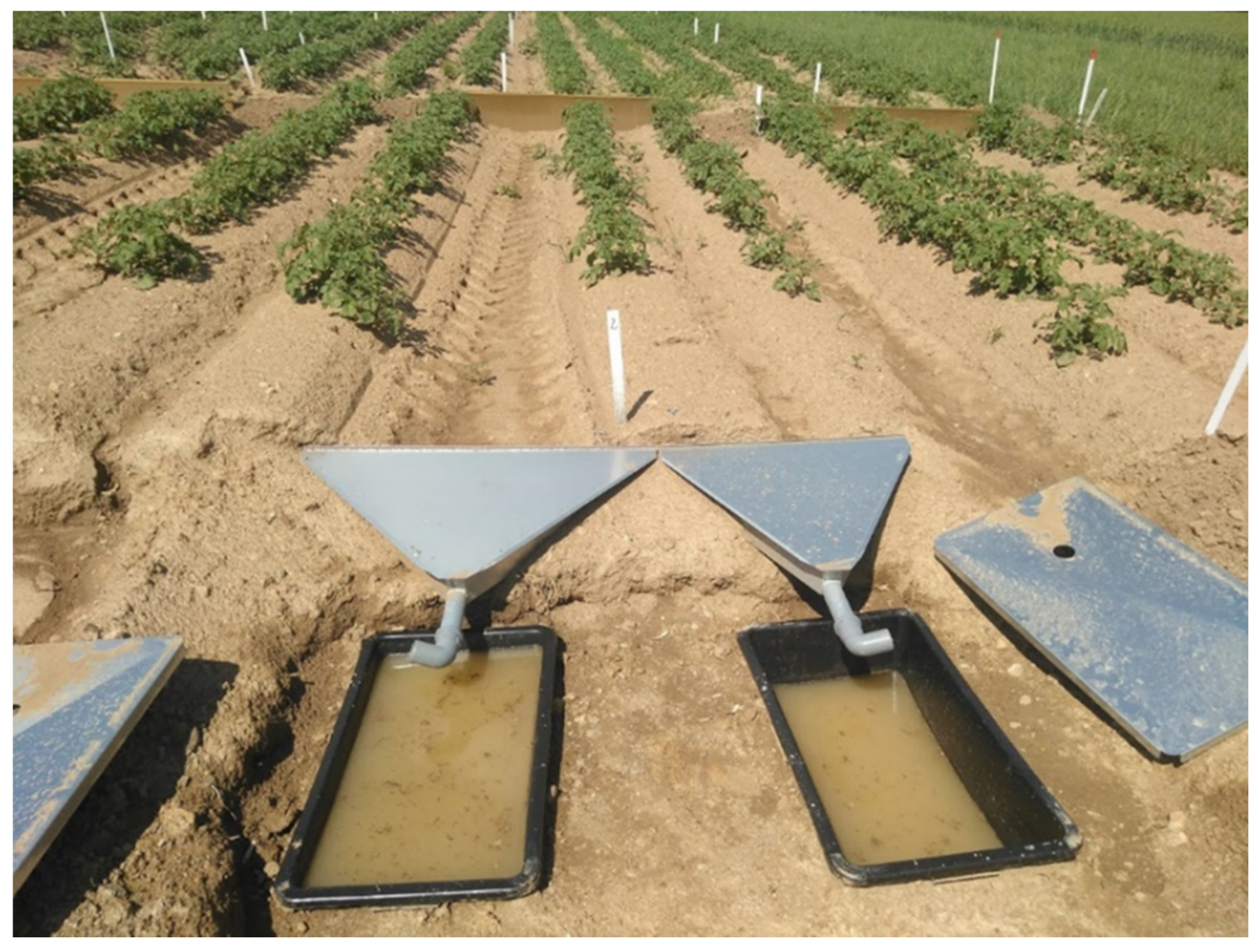

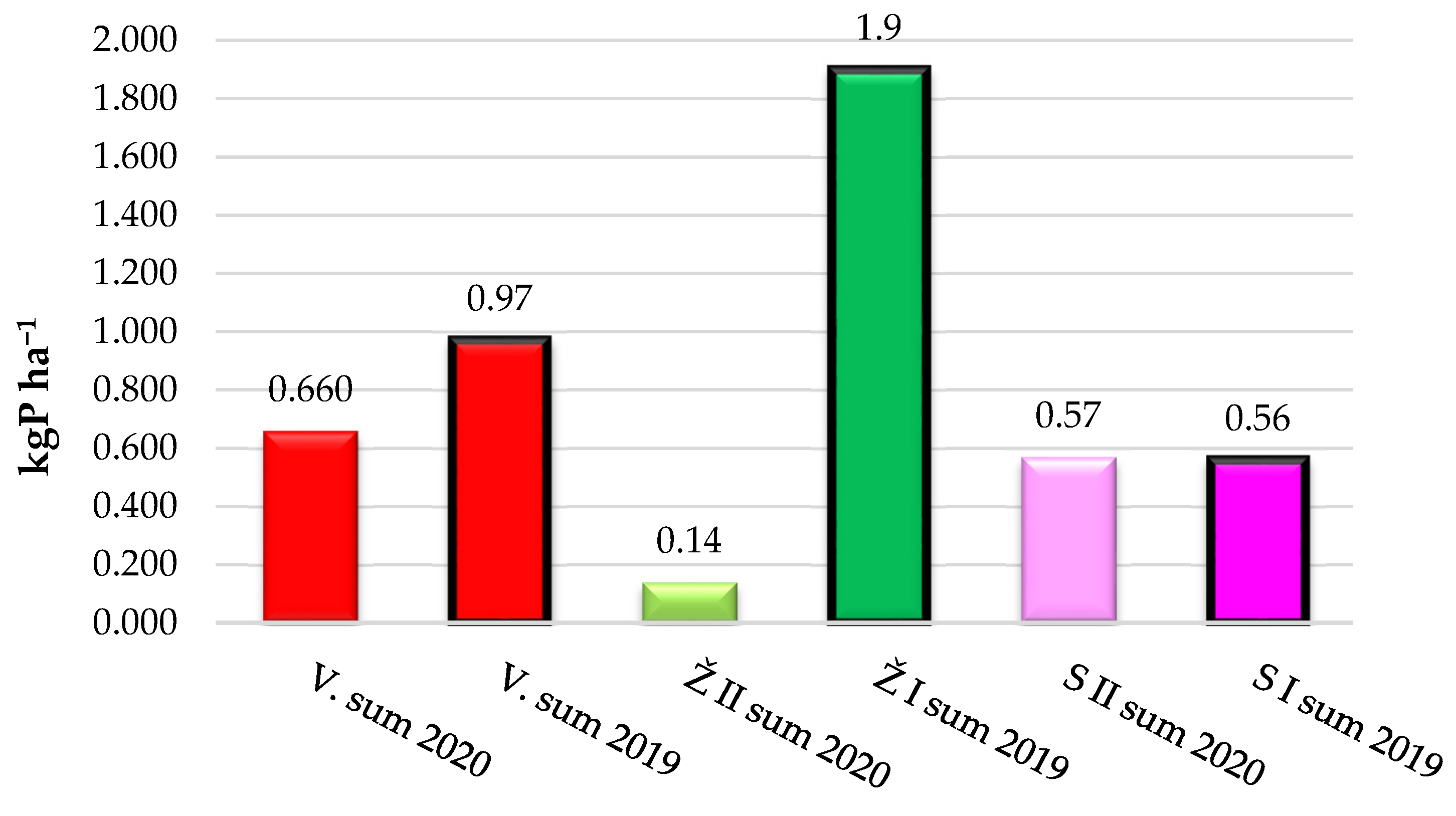
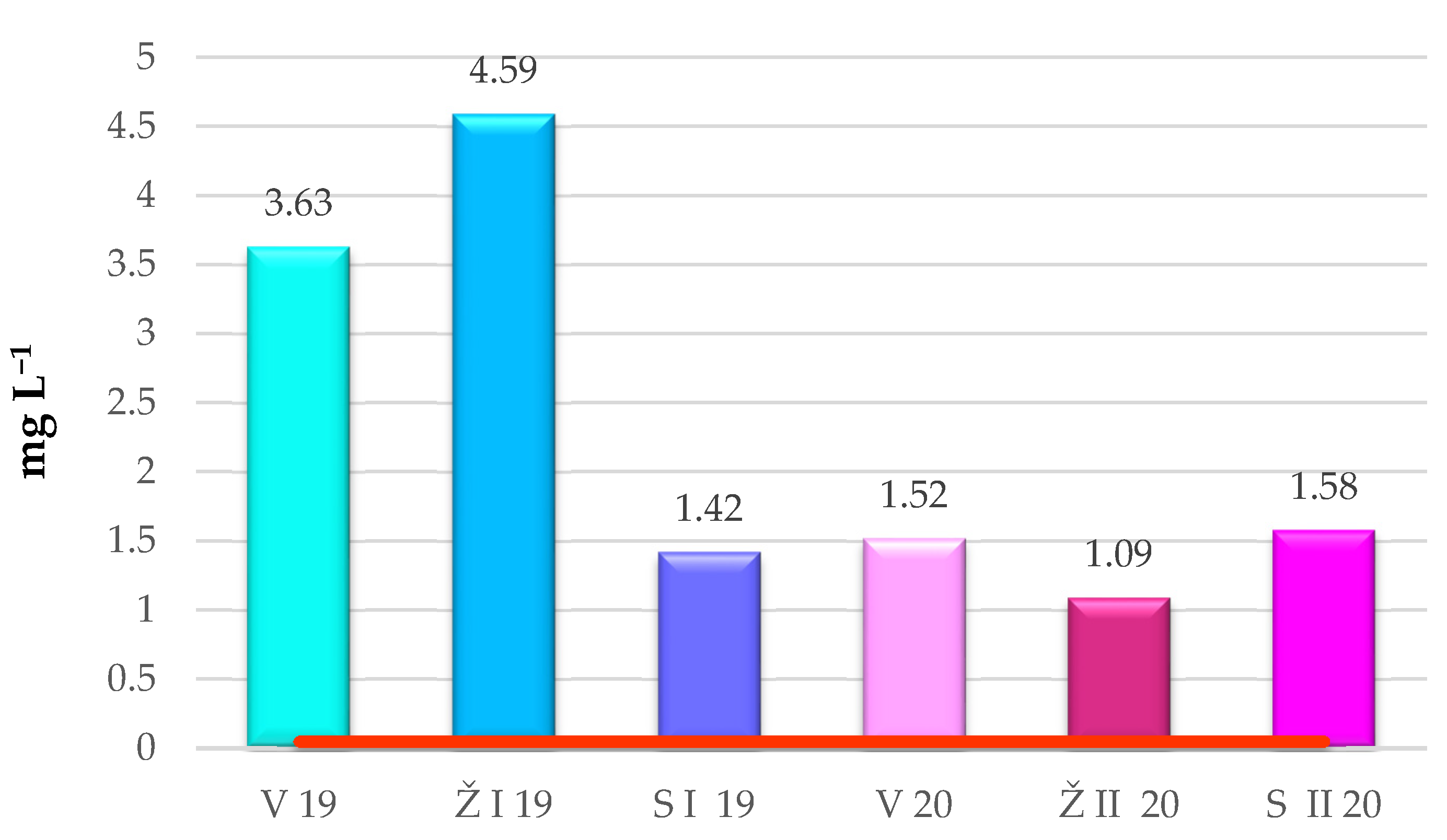
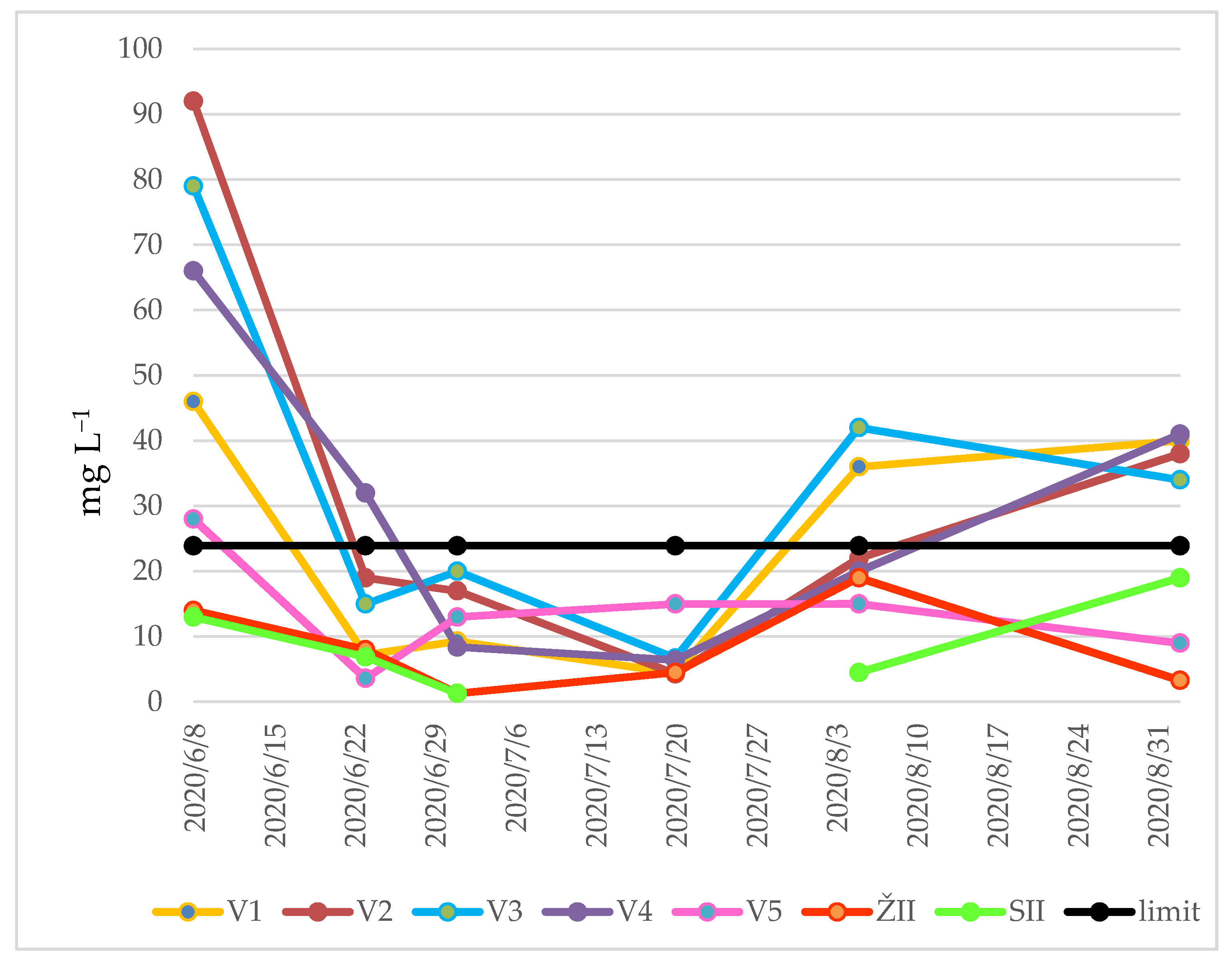
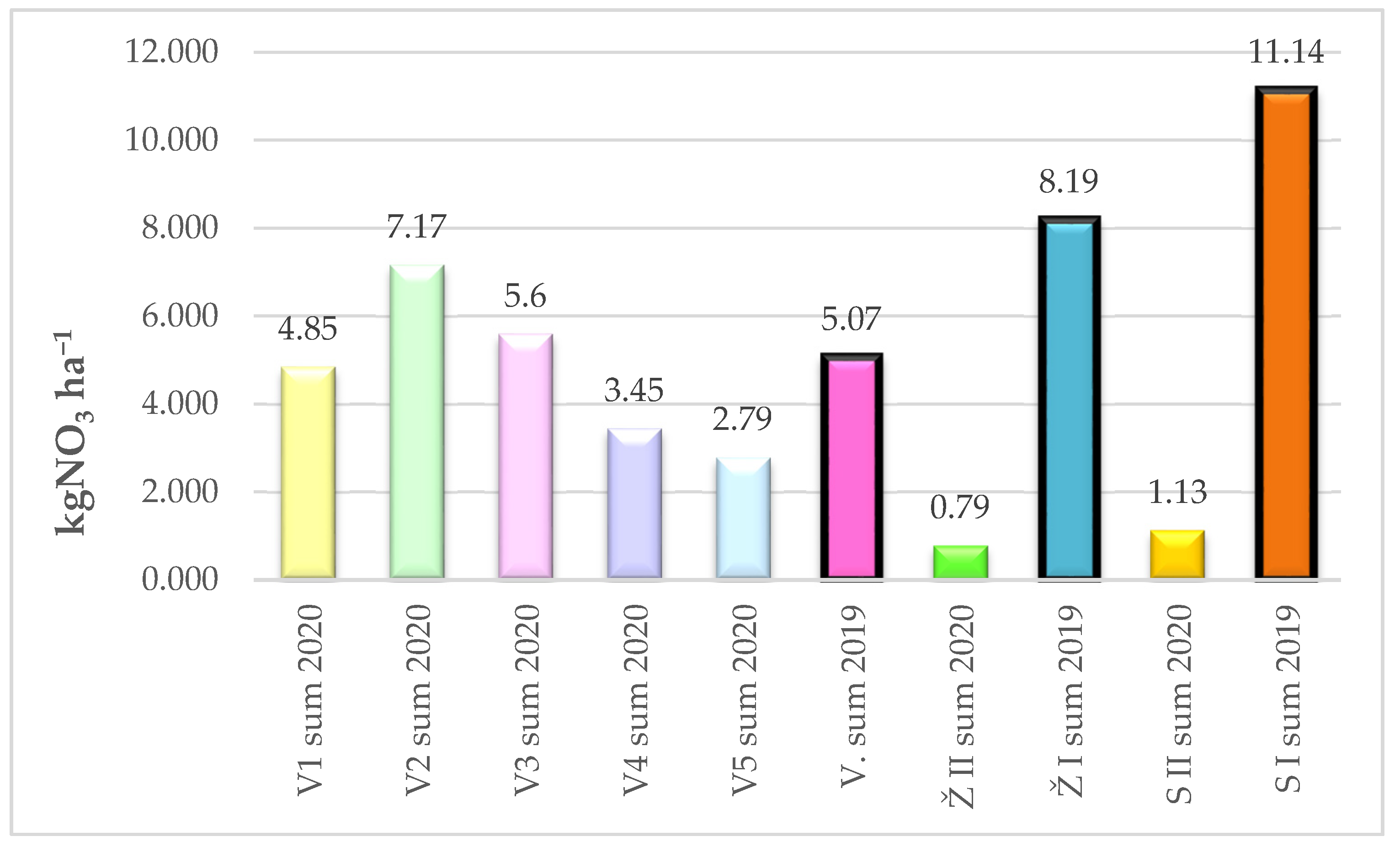
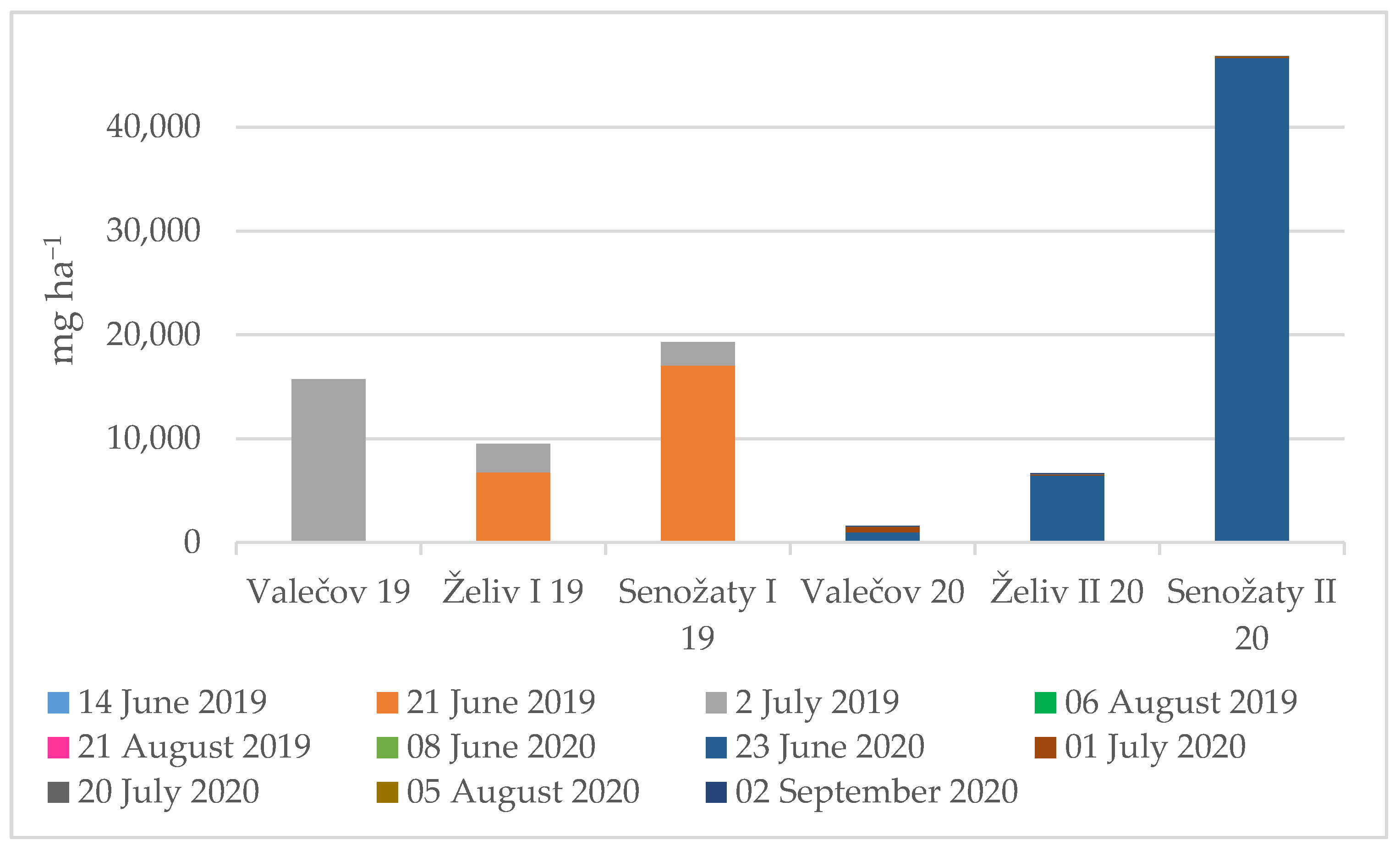
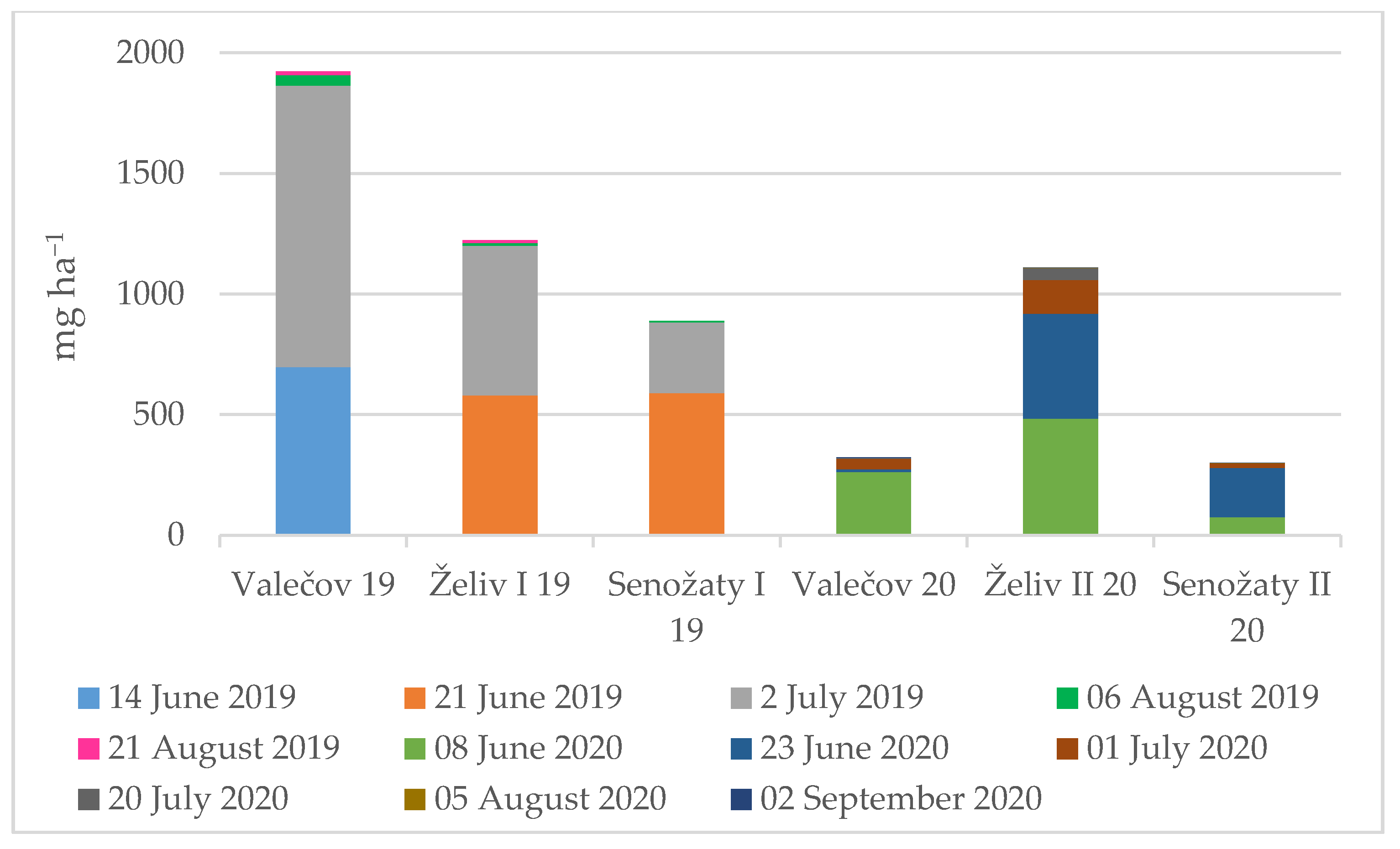
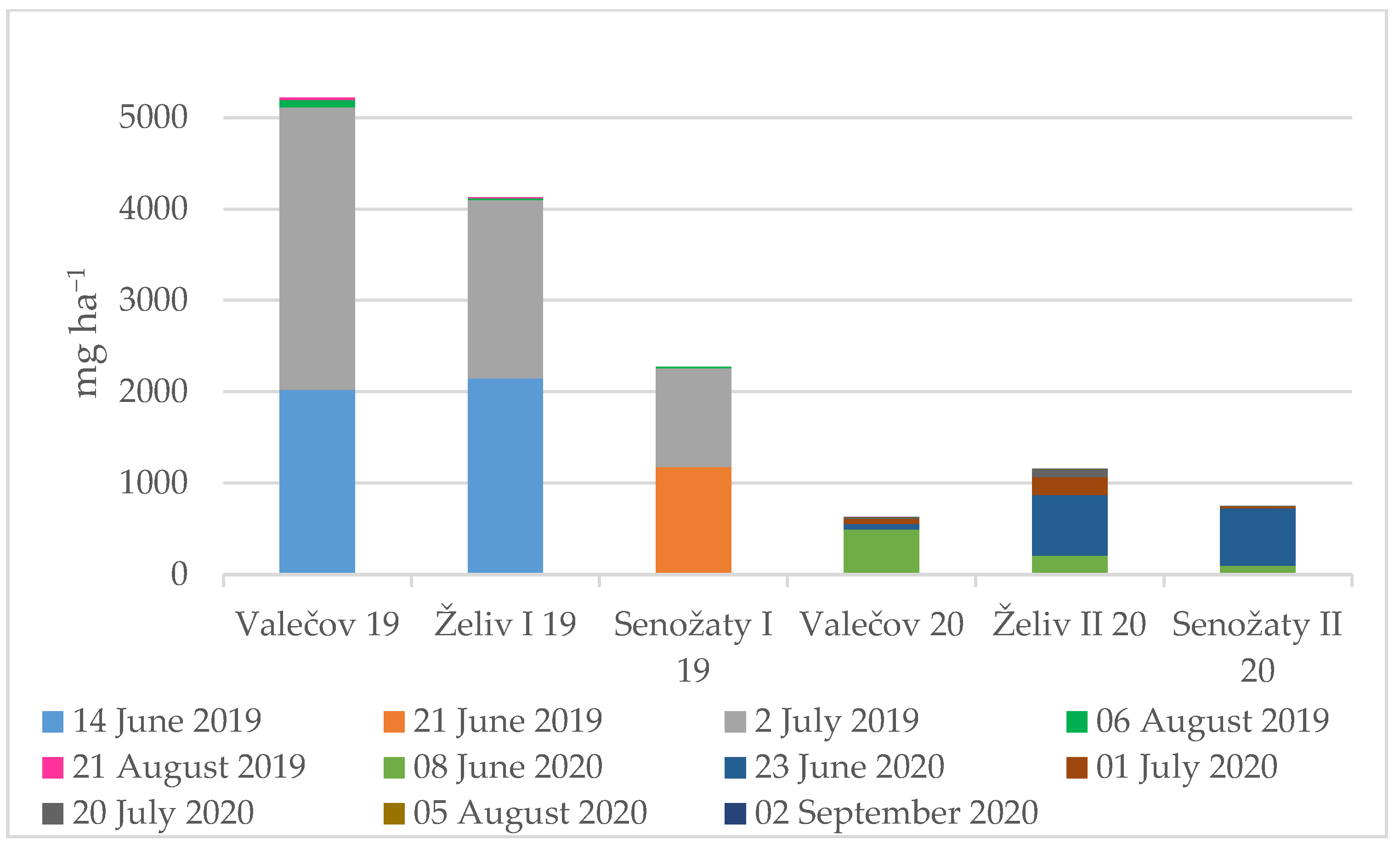
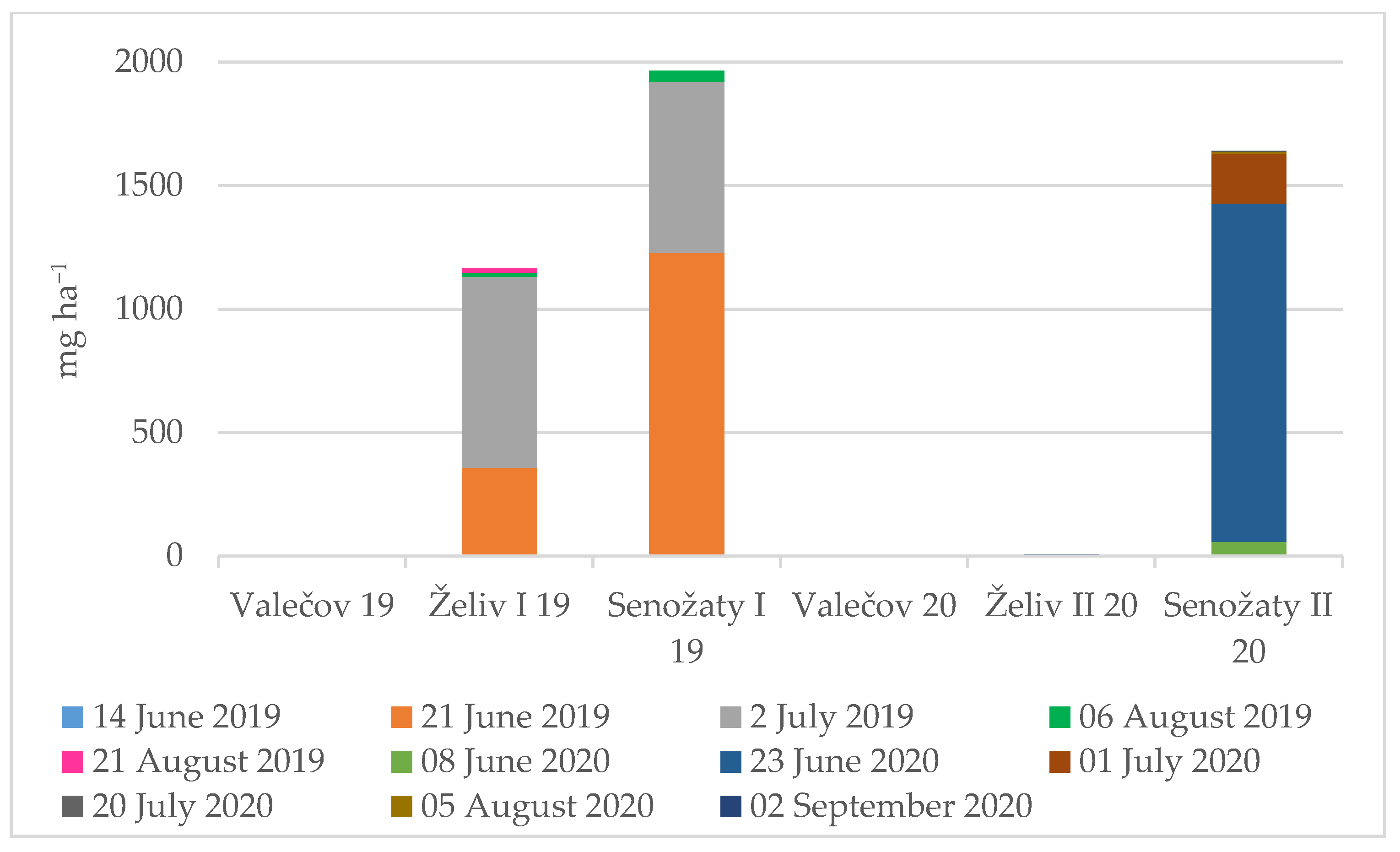
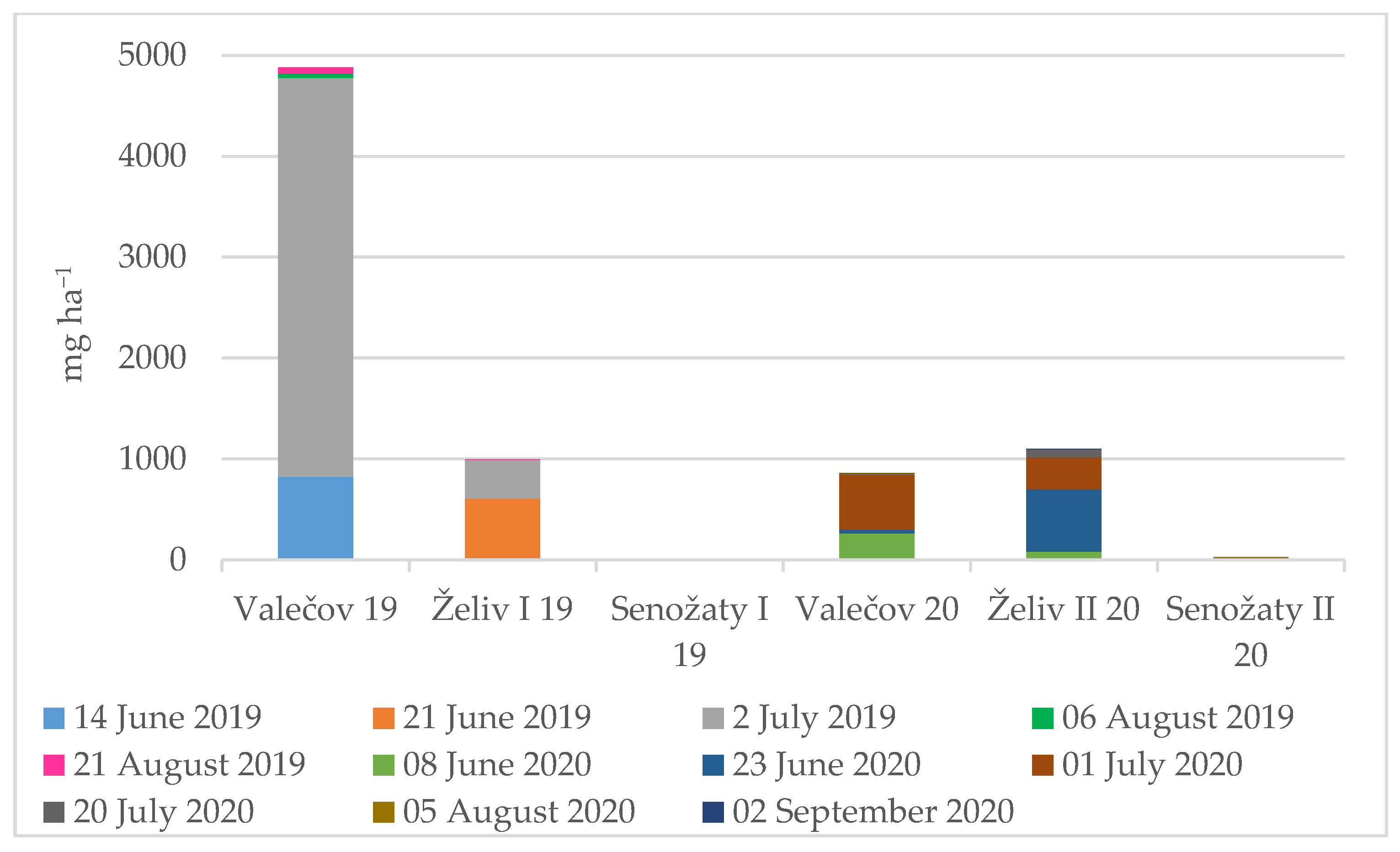
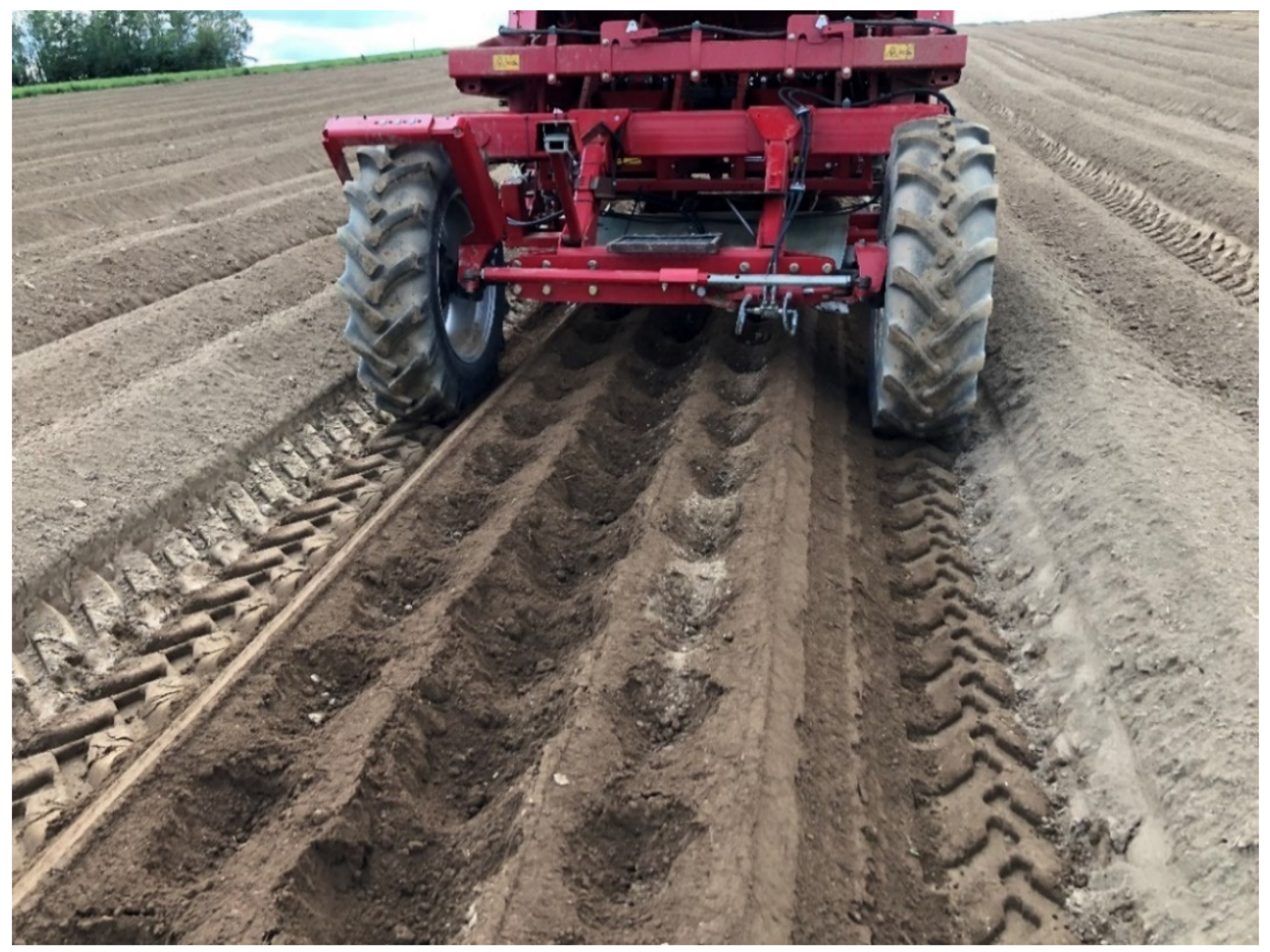
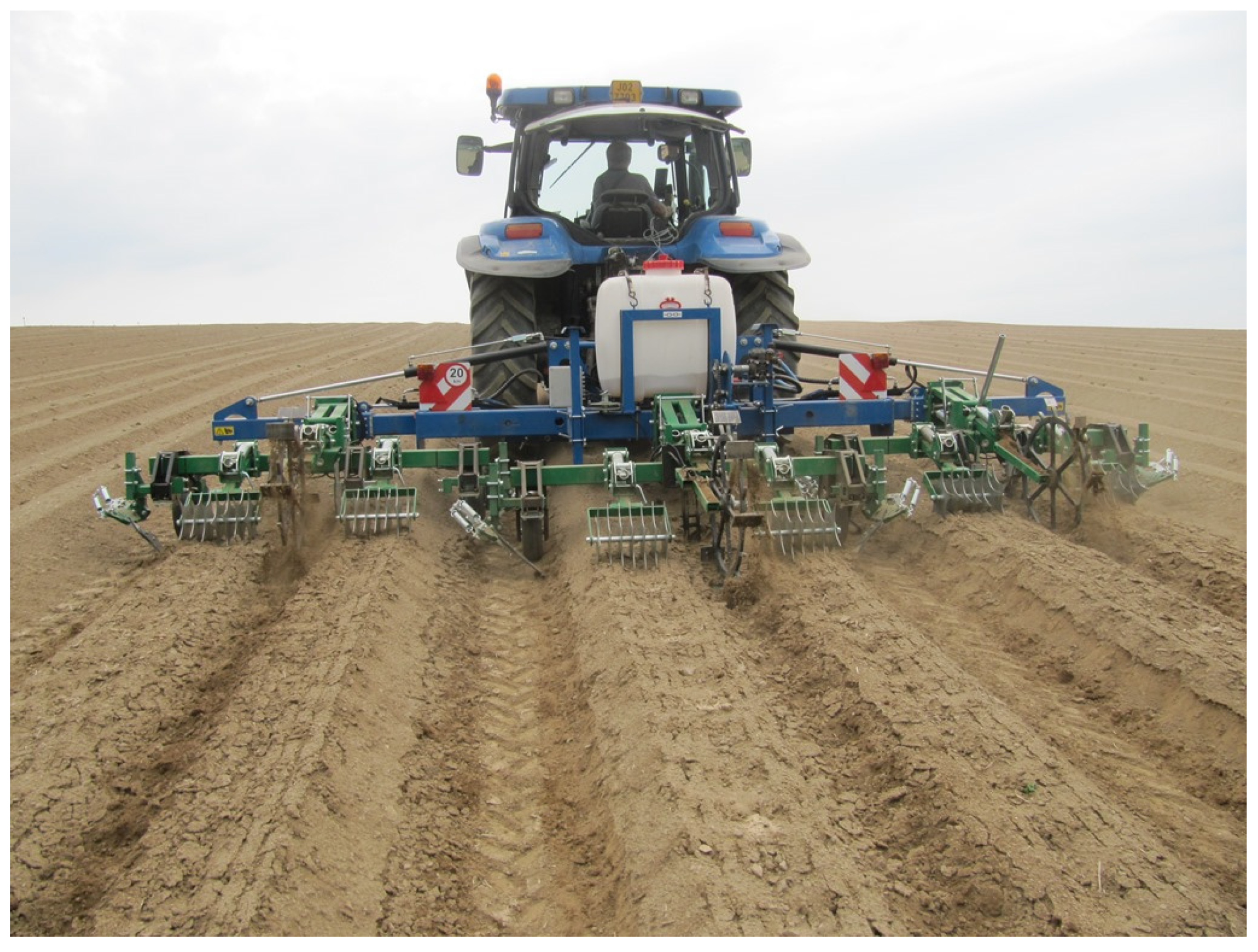
| Locality | Area m2 | GPS Coordinates | Altitude m a.s.l. | Slope ° |
|---|---|---|---|---|
| Valečov | 9 | 49.6498083° N, 15.4978117° E | 450 | 3.6 |
| Želiv I | 6.3 | 49.5252561° N, 15.2016386° E | 452 | 3.8 |
| Želiv II | 10.8 | 49.5605167° N, 15.2979603° E | 570 | 4.6 |
| Senožaty I | 10.8 | 49.5619189° N, 15.1896686° E | 480 | 3.4 |
| Senožaty II | 6.3 | 49.5296164° N, 15.1607939° E | 490 | 4.1 |
| Locality | Date | Variant | Volumetric Runoff Coefficient % | Runoff Volume (mm) | Precipitation Depth |
|---|---|---|---|---|---|
| (mm) | |||||
| VALEČOV | 1 July 2019 | 1 | 36.9 | 15.28 | 41.4 |
| VALEČOV | 17 July 2019 | 1 | 7.4 | 1.72 | 23.3 |
| VALEČOV | 22 July 2019 | 1 | 0.4 | 0.04 | 10.4 |
| VALEČOV | 22 July 2019 | 2 | 0.2 | 0.02 | 10.4 |
| VALEČOV | 2 August 2019 | 2 | 0.5 | 0.02 | 4.6 |
| VALEČOV | 5 August 2019 | 1 | 16.9 | 2.39 | 14.1 |
| VALEČOV | 5 August 2019 | 3 | 28 | 3.94 | 14.1 |
| VALEČOV | 21 August 2019 | 3 | 15.2 | 3.17 | 20.8 |
| VALEČOV | 21 August 2019 | 2 | 15.2 | 3.17 | 20.8 |
| VALEČOV | 21 August 2019 | 1 | 4 | 0.83 | 20.8 |
| ŽELIV I | 19 June 2019 | 1 | 14.1 | 4.37 | 31 |
| ŽELIV I | 21 June 2019 | 1 | 22.8 | 12.54 | 55.1 |
| ŽELIV I | 2 July 2019 | 1 | 22.8 | 4.56 | 20 |
| ŽELIV I | 18 July 2019 | 1 | 0.4 | 0.11 | 30 |
| ŽELIV I | 23 July 2019 | 1 | 14.6 | 2.34 | 16 |
| ŽELIV I | 23 July 2019 | 2 | 4.7 | 0.75 | 16 |
| ŽELIV I | 31 July 2019 | 1 | 1 | 0.12 | 12.2 |
| ŽELIV I | 31 July 2019 | 2 | 0.4 | 0.05 | 12.2 |
| ŽELIV I | 6 August 2019 | 1 | 6.5 | 1.31 | 20 |
| ŽELIV I | 6 August 2019 | 3 | 2.6 | 0.52 | 20 |
| ŽELIV I | 6 August 2019 | 2 | 0.8 | 0.15 | 20 |
| ŽELIV I | 13 August 2019 | 3 | 0.4 | 0.16 | 44.6 |
| ŽELIV I | 13 August 2019 | 2 | 0.1 | 0.03 | 44.6 |
| ŽELIV I | 13 August 2019 | 1 | 0.01 | 0.02 | 44.6 |
| ŽELIV I | 21 August 2019 | 3 | 3.3 | 1.15 | 34.9 |
| ŽELIV I | 21 August 2019 | 2 | 0.2 | 0.08 | 34.9 |
| ŽELIV I | 21 August 2019 | 1 | 3.5 | 1.23 | 34.9 |
| SENOŽATY I | 19 June 2019 | 1 | 35.3 | 10.95 | 31 |
| SENOŽATY I | 21 June 2019 | 1 | 14.1 | 7.78 | 55.1 |
| SENOŽATY I | 2 July 2019 | 1 | 56.9 | 11.39 | 20 |
| SENOŽATY I | 18 July 2019 | 1 | 7.8 | 2.34 | 30 |
| SENOŽATY I | 23 July 2019 | 1 | 38.2 | 6.11 | 16 |
| SENOŽATY I | 23 July 2019 | 2 | 27 | 4.33 | 16 |
| SENOŽATY I | 31 July 2019 | 1 | 29.9 | 3.65 | 12.2 |
| SENOŽATY I | 31 July 2019 | 2 | 12.7 | 1.55 | 12.2 |
| Locality | Date | Variant | Volumetric Runoff Coefficient % | Runoff Volume | Precipitation Depth (mm) |
|---|---|---|---|---|---|
| (mm) | |||||
| VALEČOV | 8 June 2020 | 1 | 14.8 | 2.83 | 19.1 |
| VALEČOV | 8 June 2020 | 2 | 5.4 | 1.03 | 19.1 |
| VALEČOV | 8 June 2020 | 3 | 2.7 | 0.51 | 19.1 |
| VALEČOV | 8 June 2020 | 4 | 5.7 | 1.09 | 19.1 |
| VALEČOV | 8 June 2020 | 5 | 11.9 | 2.28 | 19.1 |
| VALEČOV | 23 June 2020 | 1 | 15 | 6.3 | 42.1 |
| VALEČOV | 23 June 2020 | 2 | 11.7 | 4.94 | 42.1 |
| VALEČOV | 23 June 2020 | 3 | 8.7 | 3.67 | 42.1 |
| VALEČOV | 23 June 2020 | 4 | 8.6 | 3.63 | 42.1 |
| VALEČOV | 23 June 2020 | 5 | 7.8 | 3.3 | 42.1 |
| VALEČOV | 1 July 2020 | 1 | 27.1 | 16.22 | 59.9 |
| VALEČOV | 1 July 2020 | 2 | 25.6 | 15.33 | 59.9 |
| VALEČOV | 1 July 2020 | 3 | 27.1 | 16.22 | 59.9 |
| VALEČOV | 1 July 2020 | 4 | 22.3 | 13.33 | 59.9 |
| VALEČOV | 1 July 2020 | 5 | 19.1 | 11.44 | 59.9 |
| VALEČOV | 20 July 2020 | 1 | 18.6 | 9.8 | 52.6 |
| VALEČOV | 20 July 2020 | 2 | 15.7 | 8.27 | 52.6 |
| VALEČOV | 20 July 2020 | 3 | 17.1 | 9 | 52.6 |
| VALEČOV | 20 July 2020 | 4 | 3.7 | 1.97 | 52.6 |
| VALEČOV | 20 July 2020 | 5 | 4.8 | 2.52 | 52.6 |
| VALEČOV | 5 August 2020 | 1 | 3.8 | 1.61 | 42.6 |
| VALEČOV | 5 August 2020 | 2 | 12.8 | 5.44 | 42.6 |
| VALEČOV | 5 August 2020 | 3 | 3.4 | 1.44 | 42.6 |
| VALEČOV | 5 August 2020 | 4 | 2 | 0.83 | 42.6 |
| VALEČOV | 5 August 2020 | 5 | 2 | 0.83 | 42.6 |
| VALEČOV | 2 September 2020 | 1 | 2.3 | 1.42 | 60.9 |
| VALEČOV | 2 September 2020 | 2 | 4.8 | 2.94 | 60.9 |
| VALEČOV | 2 September 2020 | 3 | 0.9 | 0.58 | 60.9 |
| VALEČOV | 2 September 2020 | 4 | 0.6 | 0.39 | 60.9 |
| VALEČOV | 2 September 2020 | 5 | 0.8 | 0.48 | 60.9 |
| ŽELIV II | 9 June 2020 | 0 | 1.46 | 0.66 | 44.9 |
| ŽELIV II | 23 June 2020 | 0 | 14.14 | 6.02 | 109.4 |
| ŽELIV II | 30 June 2020 | 0 | 5.5 | 8.61 | 60.9 |
| ŽELIV II | 15 July 2020 | 0 | 6.2 | 2.19 | 35.4 |
| ŽELIV II | 6 August 2020 | 0 | 0.59 | 0.37 | 62.9 |
| ŽELIV II | 3 September 2020 | 0 | 0.39 | 0.19 | 50 |
| SENOŽATY II | 9 June 2020 | 0 | 3.92 | 1.76 | 44.9 |
| SENOŽATY II | 23 June 2020 | 0 | 9.06 | 9.91 | 109.4 |
| SENOŽATY II | 30 June 2020 | 0 | 7.3 | 4.44 | 60.9 |
| SENOŽATY II | 6 August 2020 | 0 | 0.66 | 0.42 | 62.9 |
| SENOŽATY II | 18 August 2020 | 0 | 1.27 | 0.14 | 10.9 |
| Locality | NO3 Average Concentration mg L−1 | Runoff Coefficient % | Sum of Precipitation mm |
|---|---|---|---|
| V 19 | 26.8 | 11.7 | 206 |
| S I 19 | 21.1 | 27.8 | 164 |
| Ž I 19 | 36.7 | 5.8 | 263 |
| V 20 | 31.7 | 10.23 | 297.2 |
| S II 20 | 20.36 | 4.7 | 289 |
| Ž II20 | 8 | 4.4 | 363.5 |
| Active Substance | Max Concentration µg L−1 | Locality | Date |
|---|---|---|---|
| aclonifen | 19.731 | Želiv I | 21 June 2019 |
| clomazone | 73.5 | Želiv II | 9 June 2020 |
| flufenacet | 41.794 | Valečov | 14 June 2019 |
| flurochloridone | 28.126 | Senožaty I | 21 June 2019 |
| metribuzin | 103.32 | Valečov | 14 June 2019 |
| prosulfocarb | 65.002 | Valečov | 14 June 2019 |
| rimsulfuron | 22.3 | Senožaty II | 23 June 2020 |
| bentazone | 471 | Senožaty II | 23 June 2020 |
Publisher’s Note: MDPI stays neutral with regard to jurisdictional claims in published maps and institutional affiliations. |
© 2021 by the authors. Licensee MDPI, Basel, Switzerland. This article is an open access article distributed under the terms and conditions of the Creative Commons Attribution (CC BY) license (https://creativecommons.org/licenses/by/4.0/).
Share and Cite
Oppeltová, P.; Kasal, P.; Krátký, F.; Hajšlová, J. Analysis of Selected Water Quality Indicators from Runoff during Potato Cultivation after Natural Precipitation. Agriculture 2021, 11, 1220. https://doi.org/10.3390/agriculture11121220
Oppeltová P, Kasal P, Krátký F, Hajšlová J. Analysis of Selected Water Quality Indicators from Runoff during Potato Cultivation after Natural Precipitation. Agriculture. 2021; 11(12):1220. https://doi.org/10.3390/agriculture11121220
Chicago/Turabian StyleOppeltová, Petra, Pavel Kasal, František Krátký, and Jana Hajšlová. 2021. "Analysis of Selected Water Quality Indicators from Runoff during Potato Cultivation after Natural Precipitation" Agriculture 11, no. 12: 1220. https://doi.org/10.3390/agriculture11121220
APA StyleOppeltová, P., Kasal, P., Krátký, F., & Hajšlová, J. (2021). Analysis of Selected Water Quality Indicators from Runoff during Potato Cultivation after Natural Precipitation. Agriculture, 11(12), 1220. https://doi.org/10.3390/agriculture11121220






